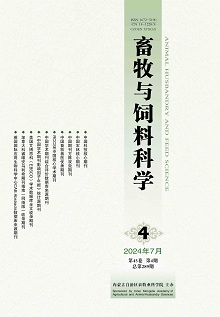Select
Effects of Gossypol on Growth Performance,Serum Antioxidant Capacity and Renal Pathological Morphology in Male Broilers
LI Ashi, LIU Pan, ZHANG Xinnan, HU Yulu, LI Yujie, ZHAO Yang, WU Shangze, HE Jianzhong, ZHANG Mengdi
Animal Husbandry and Feed Science
2023, 44 (6 ):
22-30.
DOI: 10.12160/j.issn.1672-5190.2023.06.003
[Objective] This study aimed to assess the effects of gossypol on growth performance, serum antioxidant capacity, and renal pathological morphology of male broilers at different growth stages, so as to accumulate basic experimental data for the rational application of cotton seed meal in broiler breeding. [Method] A total of 48 healthy 1-day-old Liangfenghua male broilers from the same batch were selected and randomly allocated to 4 groups according to the principle of similar body weight, including a control group (C), a low-dose group (L), a medium-dose group (M), and a high-dose group (H). Each group had 4 replicates, with 3 broilers per replicate. The experimental broilers in different groups fed the same basal diet. In addition, the broilers in L, M and H group were orally administered 100, 150 and 200 mg/(kg·BW) gossypol once a day until 20-day-old, for a total of 20 days, respectively, while those in C group were orally given distilled water. During the experiment, the feed intake and weight gain of the broilers in each group were recorded, and the feed to weight gain ratio at different growth stages were calculated. Blood samples were collected at 6, 11, 16 and 21 days of age, and the serum activities of catalase (CAT) and glutathione peroxidase (GSH-Px) were measured. Kidney tissue samples were collected at 21 days of age, with HE staining sections prepared, and changes in renal histopathology observed. [Result] At 1-15 days of age, the feed to weight gain ratios of L, M and H groups were extremely significantly (P <0.01) higher than that of C group; at 6-15 days of age, the feed to weight gain ratio of M group was extremely significantly (P <0.01) higher than that of L group; at 16-20 days of age, the feed to weight gain ratios of L and H groups were extremely significantly (P <0.01) higher than that of C group, while that of M group had negative increase. At 6-21 days of age, the serum activities of CAT and GSH-Px in C group showed upward trends, while those in L, M and H groups all showed downward trends; at 11 days of age, the serum activities of CAT and GSH-Px in L group were significantly (P <0.05) lower than those in C group, while the serum activity of GSH-Px in M and H groups was extremely significantly (P <0.01) lower than that in C group; at 16 and 21 days of age, the serum activities of CAT and GSH-Px in L, M and H groups were all extremely significantly (P <0.01) lower than those in C group; at 21 days of age, the serum activity of GSH-Px in M group was extremely significantly (P <0.01) lower than that in L group. Pathological histology observations showed that the renal glomeruli of the broilers given gossypol by gavage were swollen, the renal capsule space became narrower, and the renal tubules were necrotic.The degree of renal tissue damage was M group>H group>L group. [Conclusion] Starting from 1-day-old, feeding male broilers with doses of 100, 150 and 200 mg/(kg·BW) of gossypol for 20 consecutive days by gavage reduced growth performance, decreased serum antioxidant capacity, and caused kidney damage. With the prolongation of gossypol feeding time, the above affects were the most obvious at the dose of 150 mg/(kg·BW).
Reference |
Related Articles |
Metrics







